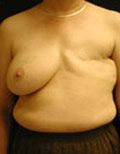Conveniently located for Fairfield County & Westchester patients
 WHAT IS BREAST RECONSTRUCTION SURGERY?
WHAT IS BREAST RECONSTRUCTION SURGERY?
For women who have undergone a mastectomy due to breast cancer, breast reconstruction surgery is a way to help them rebuild their breasts and regain their self-confidence as a woman. It is typically performed on women who have recently had a mastectomy and have a low-level risk of recurrence.
TYPES OF BREAST RECONSTRUCTION SURGERY
- TISSUE EXPANSION – During this procedure, a balloon expander is placed underneath the chest muscle. The balloon is slowly injected with the salt-water solution that expands the balloon and stretches the skin. This expansion occurs over for several weeks or months. Once the area is adequately stretched, the balloon expander is replaced with a permanent saline or silicone implant, though sometimes the balloon expander is left as the final implant. The nipple and areola are then reconstructed. This procedure has the fastest recovery time but it requires several office visits for expansion, meaning it could be weeks until a proper breast mound forms.
- TRAM FLAP AND LATISSIMUS FLAP RECONSTRUCTION – Flap breast reconstruction surgeries use either the soft tissue from the lower abdomen (TRAM Flap) or soft tissue from the back (Latissimus Flap) to create a skin tissue flap to place underneath the chest skin to create space for an implant. Occasionally the flap of tissue (which consists of skin, muscle, and fat) forms a breast mound, making an implant unnecessary. This surgery has a longer recovery time and causes discomfort in areas other than the breast, however, a proper breast mound is seen immediately after surgery.
- PREPECTORAL BREAST RECONSTRUCTION AND FAT GRAFTING – Prepectoral breast implant reconstruction is the current state-of-the-art method of implant-based breast reconstruction. Prepectoral breast reconstruction restores the shape of the breast using an implant placed directly into the empty space created by mastectomy. Without disturbing the pectoralis muscle, a silicone-filled implant wrapped in specialized material known as acellular dermal matrix is inserted immediately following mastectomy. Prepectoral reconstruction avoids the weakness, discomfort, and implants placed on top of the muscle do not flex or become distorted with pectoralis muscle flexion, upper body movements or exercise. Therefore, the unnatural movement and distortion of implants that is commonly seen when “under-the-muscle” implant reconstruction patients are moving their upper bodies or exercising (known as “muscle flex deformity” or “dynamic distortion”) is avoided. A second stage surgery using your own fat can be added a few months later to soften the edges of the implants and give you a more natural appearance.


Photo Gallery
View before-and-after pictures of real patients of Dr. Elsa Raskin
RISKS OF BREAST RECONSTRUCTION SURGERY
Like all surgical procedures, breast reconstruction surgeries come with potential risks. These risks include excessive bleeding, excessive scar tissue, adverse reaction to anesthesia, and infection. In cases of infection, a breast implant will need to be removed until the infection clears. The most common issue from breast reconstruction surgery is capsular contracture, which happens when the scar around the implant begins to tighten, causing the breast to feel hard. This surgery has no known effect on breast cancer recurrence, and it does not tend to interfere with chemotherapy or radiation treatment should cancer recur.POST-OP AND RECOVERY
After your breast reconstruction, small drainage tubes may need to be inserted into each breast. The surgical dressing will be removed within a few days and sutures should dissolve on their own in about a week. Swelling typically last for about three to five weeks, or for three to five months if implants were placed under the chest muscle. During the first two weeks after your procedure, you may experience a burning sensation in your nipples. Patients usually can return to work after a few days but are encouraged to avoid any strenuous activity for about two to three weeks. Scarring will occur with breast augmentation, but it will fade over time.“I WOULD HAPPILY BE THEIR PATIENT AGAIN.”
Dr. Elsa Raskin and office manager, Jackie were a welcoming, comforting and competent team that I decided to become a patient of when I was faced with a breast cancer diagnosis which required a mastectomy and reconstructive surgery. They are knowledgeable, approachable and have a great bedside manner. I would highly recommend Dr. Raskin and her staff for breast reconstruction and if I needed any future cosmetic surgery, I would happily be their patient again.AJP, breast reconstruction


